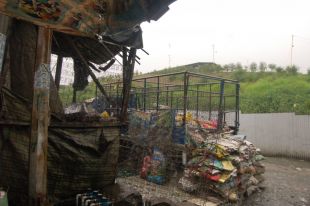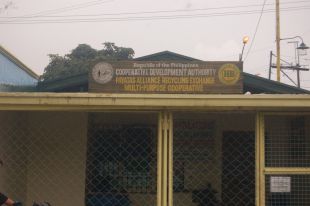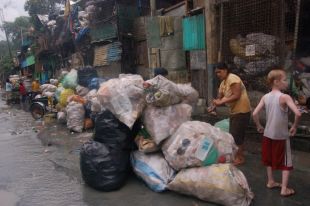From Streetlights to Health Care, Organized Scavengers Unearth Small Victories

Lisa Aquino’s truck hauls off 6,000 kilos of trash each day.
I’ve never seen so many plastic McDonald’s cups in my life. There are hundreds of them, but I’m nowhere near the Golden Arches. There are no hungry customers, no fast-food crew in brightly colored uniforms. Instead, there’s an albino boy, his blonde hair damp from the falling rain, another boy who’s thin and looks not more than 12 years old, and a woman telling them not to deceive her.
I’m on a street amid rumbling trucks and barking dogs. Rain pours from the sky, pooling in the mud, soaking the garbage. In front of me are plastic bags of trash filled with the plastic cups. The boys are weighing them one by one, along with other plastic bags that contain empty water bottles. Mylene (not her real name) is looking at the bottles, checking to see if any of them still contain liquid. “Don’t trick me. You know I pay you by the kilo,” she says as she pours water out of the bottles.
This is Payatas, a barangay (or village) in Quezon city, a place where garbage is a good thing. It’s the site of a three-hectare sanitary landfill that receives 1,300 tons of trash each day. Almost every house has bags of trash piled in front of it instead of a gate or a fence. And instead of a car, what’s parked outside the houses are garbage trucks.

Trash outside a home in Payatas.
The putrid odor of the trash wafts all the way down to Litex market, some 500 meters away. But the smell doesn’t seem to disconcert the locals. The tons of garbage – all different colors, sizes and textures – are a welcome sight. “There is money from trash,” says Mylene, weighing the bags of plastic bottles that had been delivered to her that day.
In Payatas, lives are shaped by waste. Collecting trash, dumping it, recycling it into something useful – the whole process intertwines informal and formal employment, a combination that makes the system work. Mylene receives hundreds of kilos of trash everyday, which is sorted by boys like Joel (not his real name). Joel, barely five-foot-four, has a body toned firm from the work, his hands skillful in segregating intact bottles from broken ones.
Joel explains to me that even though he sorts trash on the ground, he is actually a “jumper.”
“We are not scavengers. We’re the ones who collect recyclable trash from different places,” he says.
“You’re the ones who jump in and out of the garbage trucks with the trash bags?” I ask.
“Yes, that’s what I do,” he says, smiling.
Joel gets paid less than a dollar for every kilo of recyclable trash he collects. He and other jumpers deliver it to junk shop owners like Mylene, who earns an average of P1,500 ($34 USD) each day from the trash to companies that process and recycle it. “We get the trash, sell them to a company in Valenzuela [a highly-urbanized city] that uses plastics. The company in Valenzuela sends them to another company that recycles them,” she says.

The entrance to PARE’s headquarters.
“I am an outsider,” adds Mylene. “Outsider” is what people call junk shop owners and scavengers who aren’t members of the Payatas Alliance Recycling Exchange Multi-Purpose Cooperative, or PARE.
PARE was formed eight years after a 2000 tragedy in which a landslide killed 218 people in the then-open dumpsite. The mountain, whose slope used to be a steep 70-degrees, has since been beveled to 40 degrees and was converted to a sanitary landfill in 2011. Lisa Aquino, one of the junk shop owners that originally formed PARE in 2008, says the cooperative aims to ensure that scavengers are properly compensated and can obtain social security benefits.
But the sanitary-landfill conversion two years ago limited the volume of waste that goes to Payatas, nearly halving the waste pickers’ incomes. So the Payatas Operations Group (POG), which had been established by the Quezon City government in 2001, devised a system in which scavengers could continue earning money from waste, providing them areas where they could pick recyclable materials. POG also helped with the establishment of the scavengers’ association. To remain a part of the association, scavengers have to save up at least P312 (about $7 USD) every month. “They have these slots up there by the landfill,” says Aquino. “[The scavengers] put coins in the slots and [we] collect them every month. If there is excess money, it becomes part of their savings.”

Selling trash by the kilo.
But while POG oversees the operations of the dumpsite, and PARE looks out for the scavengers’ rights — the cooperative makes sure that all scavengers carry ID, for instance, and that minors aren’t being employed — neither group has any control over the labor relations between scavengers and junk shop owners. The junk shop owners still get to decide how much to pay their scavengers, which, in Aquino’s case, includes 30 to 40 people.
Such basic protections didn’t exist in the past, according to Elaine Vallena, who started working as a scavenger at 14 years old. These days, Vallena works five days a week, earning a minimum of $4 a day. Sometimes she’ll see jewelry — rings, necklaces, and other “class A” metal, which scavengers call the “yellows.” Occasionally she’ll see things that aren’t supposed to be there. “I once saw an arm,” she tells me nonchalantly. “Looked like it was chopped off.”
She was also hurt once, when she stepped on a nail. This was before PARE was formed. Now, with PARE and the scavengers’ associations, there would be ready medical assistance, says Aquino. But this can only help so much — the life of a scavenger remains fairly hazardous. “Some scavengers die from getting struck by lightning,” says Vallena. “Once, a pregnant woman even died from it.”
The scavengers also have better protection since the dumpsite was lit with streetlights, which get their electricity from converted biogas emissions from the dump, an innovation introduced by the private firm PANGEA Philippines in 2007.
I want to interview more scavengers, but Aquino and Vallena tell me none are at the dumpsite on a Sunday, the typical day of rest in the Philippines. Even a scavenger needs a break from the hunt once in a while.
Photos by Purple Romero









